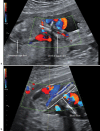Salvage of Necrotic-Appearing Limb after In Utero Endoscopic Lysis of Constriction Bands
- PMID: 28428904
- PMCID: PMC5393915
- DOI: 10.1055/s-0037-1602125
Salvage of Necrotic-Appearing Limb after In Utero Endoscopic Lysis of Constriction Bands
Abstract
We report a case of amniotic band syndrome complicated by constriction bands and marked distal swelling of both lower extremities. Color Doppler interrogation of the right lower extremity revealed complete lack of blood flow below the level of the constriction. Upon fetoscopic survey, the right lower extremity beyond the constriction band appeared dusky red and discolored with desquamation, consistent with a necrotic appearance. The constriction bands were cut in utero using endoshears, thereby allowing restoration of blood flow on postoperative day 1. The patient was counseled extensively regarding the possibility of limb dysfunction or amputation. However, the baby was born with functional lower extremities, and at 21 months of age, the child was cruising and jumping on his own. This case demonstrates that there is unique plasticity in fetal limb recovery after a severe ischemic injury that is not otherwise seen in postnatal life. Reperfusion of the necrotic-appearing limb resulted in restoration of appearance and function without apparent deleterious effects on the fetus. We believe the favorable outcome in this case was likely due to timeliness of the in utero lysis of amniotic bands and the plasticity of fetal healing.
Keywords: amniotic band syndrome; constriction band; fetoscopy; reperfusion.
Figures




References
-
- Zhao Y, Zhang M, Zhou Q, Tang K, Wang L, Gong Z. Fetal dorsalis pedis artery velocimetry in the second and third trimesters. J Ultrasound Med. 2013;32(07):1227–1232. - PubMed
-
- Quintero R A, Morales W J, Phillips J, Kalter C S, Angel J L. In utero lysis of amniotic bands. Ultrasound Obstet Gynecol. 1997;10(05):316–320. - PubMed
-
- Richter J, Wergeland H, DeKoninck P, De Catte L, Deprest J A. Fetoscopic release of an amniotic band with risk of amputation: case report and review of the literature. Fetal Diagn Ther. 2012;31(02):134–137. - PubMed
-
- Ronderos-Dumit D, Briceño F, Navarro H, Sanchez N. Endoscopic release of limb constriction rings in utero. Fetal Diagn Ther. 2006;21(03):255–258. - PubMed
Publication types
LinkOut - more resources
Full Text Sources
Other Literature Sources

